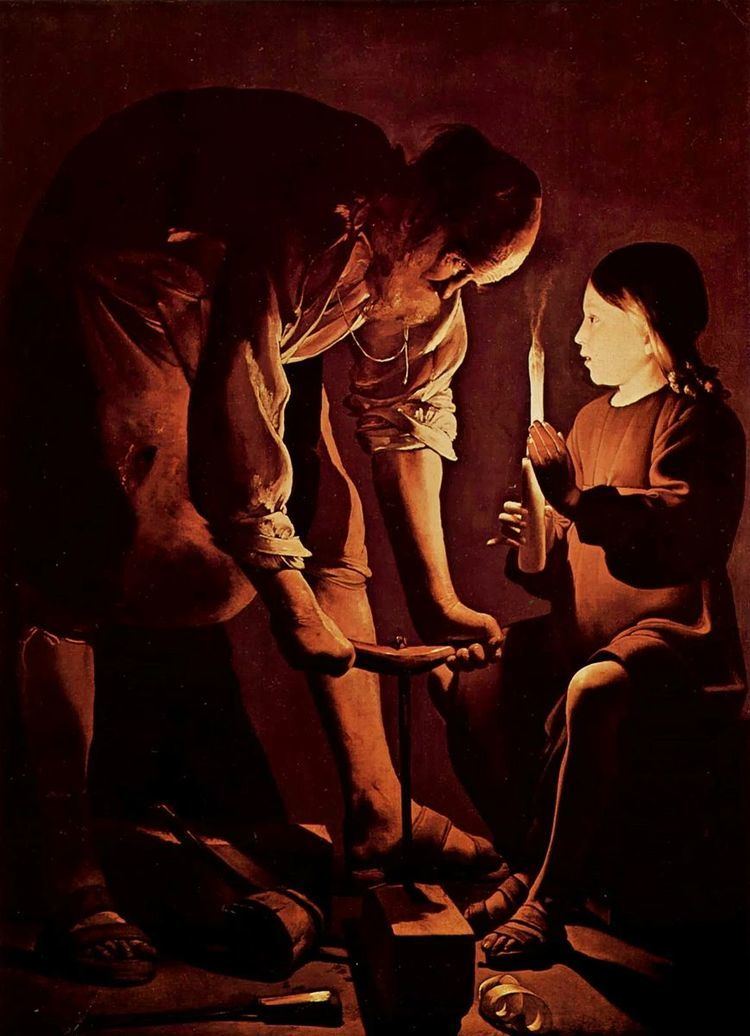 | ||
The Ancient Greek noun tektōn (τέκτoν) is a common term for an artisan/craftsman, in particular a carpenter or wood-worker or builder. The term is frequently contrasted with an iron-worker, or smith (χαλκεύς) and the stone-worker or mason (λιθολόγος),
Contents
Septuagint
The characteristic Ancient Greek distinction between the general worker or wood-worker and the stonemason and the metal-worker occurs frequently in the Septuagint:
The distinction occurs in lists of workmen working on building or repairs to the temple in Jerusalem, for example in the repairs carried out under the priest Jehoiada and "the carpenters and builders, that wrought upon the house of the LORD,... And to masons, and hewers of stone, and to buy timber and hewed stone to repair the breaches of the house of the LORD," in 2 Kings 12:11-12. This same incident is recounted in similar language, using tekton again, in the account of Josephus.
Gospel references
The term is chiefly notable for New Testament commentators' discussion of the employment of Jesus and his adoptive father Joseph, both described as "tekton" in the New Testament. This is translated as "carpenter" in English-language Bibles.
The term occurs in combination with the definite article in the Gospel of Mark,[6:3] to describe the occupation of Jesus.
The term is also used in the Gospel of Matthew in relation to Jesus' adoptive father Joseph.[13:55]
In modern scholarship, the word has sometimes been re-interpreted from the traditional meaning of carpenter and has sometimes been translated as craftsman, as the meaning of builder is implied, but can be applied to both wood-work and stone masonry.
Hebrew naggar interpretation
In the Septuagint the Greek noun tektōn either stands for the generic Hebrew noun kharash (חרש), "craftsman," (as Isaiah 41:7) or tekton xylon (τέκτων ξύλον) as a word-for-word rendering of kharash-'etsim (חָרַשׁ עֵצִים) "craftsman of woods." (as Isaiah 44:13). The term kharash occurs 33 times in the Masoretic Text of the Hebrew Bible.
As an alternative to kharash, some authors have speculated that the Greek term corresponds to the Aramaic term naggara (Hebrew |נגר naggar "craftsman") and in 1983 Geza Vermes (1983) suggested that given that the use of the term in the Talmud "carpenter" can signify a very learned man, the New Testament description of Joseph as a carpenter could indicate that he was considered wise and literate in the Torah. This theory was later popularized by A. N. Wilson to suggest that Jesus had some sort of elevated status.
The original text with "There is no carpenter or son of carpenter that can take it apart" is found in Avodah Zarah 50b in discussion of whether to prune a tree on the Sabbath, with "carpenter" used in Isidore Epstein (Soncino) and Michael Rodkinson's translations and Ezra Zion Melamed's Lexicon. In the modern English version of the Talmud Jacob Neusner the passage reads as follows:
1.5 A. Said R. Joseph bar Abba ... "people may remove worms from a tree or patch the bark with dung during the Sabbatical Year, but people may not remove worms or patch the bark during the intermediate days of a festival. ... But there is no craftsman let alone a disciple of a craftsman who can unravel this teaching."
B. Said Rabina, "I am not a craftsman let alone a disciple of a craftsman, but I can unravel this teaching. What is the problem anyhow? ..."
However the Greek term tekton does not carry this meaning, the nearest equivalent in the New Testament is Paul's comparison to Timothy of a "workman" (ἐργάτης ergatēs) rightly "dividing" the word of truth. This has been taken as a carpentry-image by some Christian commentators. The suggested term naggar "craftsman" is not found in biblical Aramaic or Hebrew, or in Aramaic documents of the New Testament period, but is found in later Talmudic texts where the term "craftsman" is used a metaphor for a skilled handler of the word of God.
